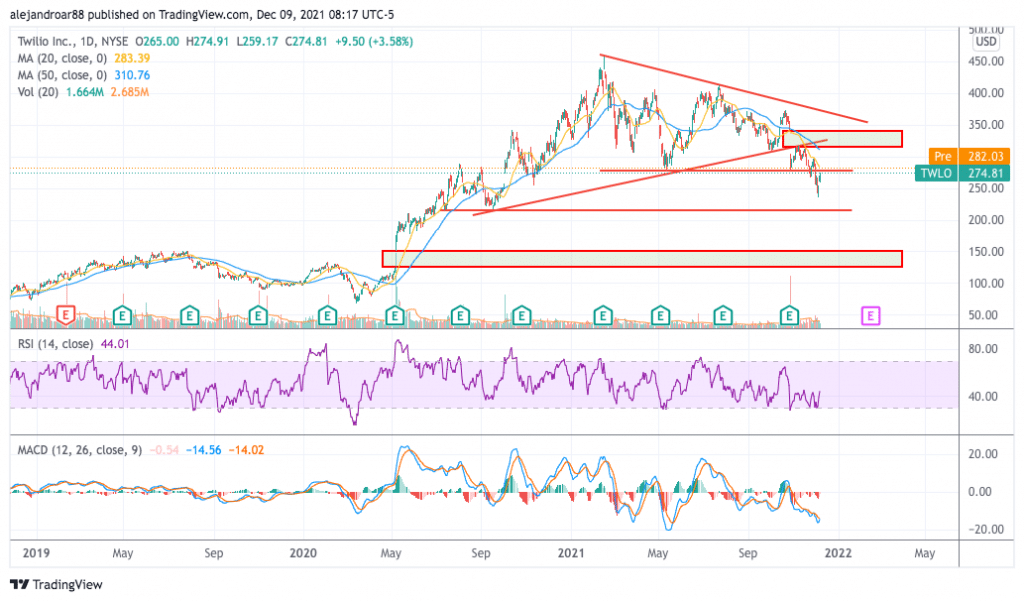Twilio Stock Down 13% in December – Time to Buy TWLO Stock?
Please note that we are not authorised to provide any investment advice. The content on this page is for information purposes only.
The price of Twilio stock has declined nearly 13% so far in December following the broad-market weakness experienced by growth stocks as a whole.
This monthly decline has come after the strong 18% drop the stock suffered back in late October when the firm reported its financial results covering the third quarter of the 2021 fiscal year as a large number of analysts cut their price targets for the stock amid a seemingly fading pandemic tailwind.
Back then, the company also announced the departure of its Chief Operating Officer (COO), George Hu, who unexpectedly left the company. Hu was substituted by the firm’s Chief Financial Officer Khozema Shipchandler.
For the market, Shipchandler may have not been considered the right pick for this position considering that most of his prior experiences are related to sales and finance.
Since that pronounced decline, the stock has shed another 4% although it seems to be attempting to make a comeback in the past couple of days as Twilio stock posted gains of 3.6% yesterday while trading 3% higher in pre-market stock trading action today at $283 per share.
Yesterday’s uptick came after the company announced that it was launching a $50 million fund named Twilio Ventures that will primarily invest in early-stage companies that promote the success of developers who are creating products within the Twilio ecosystem or in businesses that are creating innovative solutions that seek to improve customers experiences and engagement.
What can be expected from this tech stock as we are heading to the beginning of a new year? In this article, I’ll be assessing the price action and fundamentals of Twilio stock to outline plausible scenarios for the future.
68% of all retail investor accounts lose money when trading CFDs with this provider.
Twilio Stock – Technical Analysis

Back in October when I covered Twilio’s post-earnings decline, I emphasized that a break below the symmetrical triangle formation shown in the chart favored a bearish outlook for the stock.
The downtrend that followed has pushed the price of Twilio stock below multiple support areas including a break below the $280 and $255 horizontal supports.
Meanwhile, the price remains below its short-term and mid-term moving averages although today’s pre-market action is tagging the 20-day simple moving average.
Momentum indicators for Twilio are severely depressed as well with the Relative Strength Index (RSI) failing to move above the 50 level multiple times while the MACD has declined to its lowest level since May this year. This indicator remains below the signal line and histogram readings are still negative.
Even though the upticks the stock has experienced in these past few days are encouraging, it is still too early to tell if they will lead to a full-blown trend reversal. For now, Twilio stock remains on a downtrend and the outlook is bearish unless a break above the 20-day and 50-day simple moving averages occur.
Meanwhile, if the downtrend continues in the following days, the $215 level remains the next key support area to watch.
Twilio Stock – Fundamental Analysis
Twilio’s top-line growth continues to be very impressive. However, its operating losses are disconcerting and negative margins have not been declining.
The absence of a path to profitability is an important factor weighing on the outlook of Twilio stock at the moment. Meanwhile, certain unfavorable market conditions could prompt further declines in the stock as its trading multiples remain stretched.
In this regard, Twilio’s forward P/S ratio currently stands at 14.4x while its forward EV/Sales ratio is standing at 13.2x compared to an average of 11.8x for software companies that develop applications.
Even though these ratios have declined amid the post-earnings drop the stock experienced back in October, they are still quite high for a company that has not yet proven that its business model can deliver positive results to shareholders.
On a positive note, Twilio’s cash burn is quite small, its cash position is quite strong with $5.4 billion in cash and equivalents and short-term investments, and its long-term debt of $1 billion is fully covered by the firm’s liquidity.
Among the unfavorable conditions that could further depress the valuation of Twilio, a sudden increase in interest rates by the Federal Reserve or a sustained jump in US Treasury Yields could lead to a higher risk premium imposed on money-losing businesses.
All things considered, Twilio’s downside risk at the moment seems to exceed its upside potential. With this in mind, those who would like to take a long position in the business should opt to wait patiently to see if the valuation drops to a more attractive level – one that offers a higher margin of safety.






